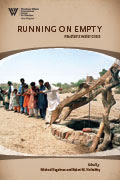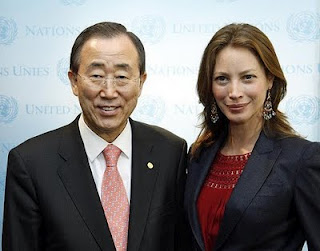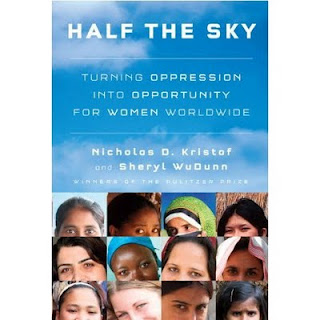-
Running on Empty: Pakistan’s Water Crisis
› “Water shortages,” warns South Asia scholar Anatol Lieven, “present the greatest future threat to the viability of Pakistan as a state and a society.
“Water shortages,” warns South Asia scholar Anatol Lieven, “present the greatest future threat to the viability of Pakistan as a state and a society.
This warning may be overstated, but Pakistan’s water situation is deeply troubling, as described in a new report from the Woodrow Wilson Center’s Asia Program, Running on Empty: Pakistan’s Water Crisis.
Water availability has plummeted from about 5,000 m3 per capita in the early 1950s to less than 1,500 m3 per capita today. As Simi Kamal reports in the first chapter of Running on Empty, Pakistan is expected to become “water-scarce” (below 1,000 m3 per capita) by 2035—though some experts project this could happen in 2020, if not earlier.
In an unstable nation like Pakistan, water shortages can easily become security threats. In April 2009, alarm bells sounded when the Taliban pushed southeast of Swat into the Buner district of the Northwest Frontier Province. Not only is Buner close to Islamabad, it lies just 60 kilometers from the prized Tarbela Dam, which provides Pakistan with billions of cubic meters of precious water for irrigation each year.
Soaked, Salty, Dirty, and Dry
According to Kamal, Pakistan faces significant and widespread water challenges:- Inefficient irrigation.
- Abysmal urban sanitation.
- Catastrophic environmental degradation.
- Lack of water laws to define water rights.
- Lack of a sound policy on large dams.
Women and Water in Rural Pakistan
Rural women and small farmers are particularly affected by Pakistan’s water crisis. Women bear the primary responsibility for obtaining water, but have been traditionally been shut out of government water-planning and decision-making processes. However, government and media initiatives, described by Sarah Halvorson in Running on Empty’s chapter on water and gender, are increasingly highlighting the importance of women’s participation.
Meanwhile, Adrien Couton reports that Islamabad’s water projects mainly benefit large and wealthy farmers—even though Pakistan has approximately four million farms smaller than two hectares.
Pakistan’s Thirsty Cities
With most of Pakistan’s water dedicated to agriculture, less than 10 percent is left for drinking water and sanitation. A quarter of Pakistanis lack access to safe drinking water—and many of them reside in the country’s teeming cities.
Worse, the drinking water that does exist is quickly disappearing. Lahore, which relies on groundwater, faces water table declines of up to 65 feet, as described by Anita Chaudhry and Rabia M. Chaudhry in their chapter on the city.
The scarcity of clean water in the cities—exacerbated by a lack of wastewater treatment—is a leading cause of deadly epidemics. At least 30,000 Karachiites (of whom 20,000 are children) perish each year from unsafe water.
Pakistan Must Act Now To Solve the Water Crisis
Pakistan arguably has the technological and financial resources to provide clean water. So what’s the hold-up? In her chapter on public health, Samia Altaf argues that the problem is the absence of a strong political lobby to advocate for water—and that no one holds Islamabad accountable for fixing the problem.
The report offers more recommendations for addressing Pakistan’s water:- Invest in existing infrastructure and in modest, indigenous technology.
- Strike appropriate balances between centralized and decentralized management.
- Devote more attention to water allocation and distribution on local/individual levels.
- Understand the links between agricultural and urban water pressures.
- Embrace the role of the private sector.
- Conserve by favoring water-saving technology; less water-intensive crops; and water-conserving urban building design.
- Address structural obstacles like systemic inequality and gender discrimination.
- Take immediate action. Tremendous population growth and rapidly melting glaciers in the Himalayas ensure that the crisis will deepen before it eases.
Michael Kugelman is the Wilson Center’s South Asia specialist. He is co-editor, with Robert M. Hathaway, of the recently published Wilson Center book Running on Empty: Pakistan’s Water Crisis, on which this post is based. Much of his work has focused on resource shortages in Pakistan and India. -
Weekly Reading
›The American Security Project (ASP) launched its Climate Security Index, which identifies climate change “a clear and present danger to the national security of the United States,” at an event hosted by George Washington University. ASP warns that “American leaders will face a multitude of tough choices as climate-induced national security threats begin to compete with and crowd out our ability to respond to traditional threats,” reports ClimateWire.
According to “Fewer Emitters, Lower Emissions, Less Cost,” contraception is almost five times cheaper than conventional green technologies as a means of combating climate change. “[E]ach $7 spent on basic family planning (2009 US$) would reduce CO2 emissions by more than one ton,” researchers conclude, while low-carbon technologies would add an extra $25 per ton.
Experts at a recent forum on sexual and reproductive health and development in Berlin also argued for making the population-climate link, although it did not appear in the Call to Action. Helen Clark, administrator of the UN Development Programme (UNDP), said that there is a “virtuous cycle formed by educating women and families in the developing world on the number of children they actually wish to have, improving the health of women and promoting gender equality, reducing poverty and hunger, and mitigating climate change.”
The World Bank has suspended International Finance Corporation (IFC) funding of operations in the palm oil sector over concerns that lending could be causing social and environmental harm, says Mongabay.com. World Bank President Robert Zoellick announced the move in a letter to NGO leaders who argued that IFC-backed palm oil production in Indonesia was fuelling deforestation, land grabbing, and human rights abuses.
In “Urban Poverty and Vulnerability in Kenya,” Oxfam warns that Kenya “is facing a new urban timebomb, with millions of Nairobi residents suffering a daily struggle for food and water as the divide between rich and poor widens.” The group points out that “the price of staple foods such as maize has more than doubled in the past year” and drought has led to an outbreak of cholera “as almost 90% of slum dwellers have no piped clean water.”
“Water and Conflict: Incorporating Peacebuilding into Water Development” from Catholic Relief Services outlines a way for development and human rights practitioners to integrate water and peacebuilding in their projects, drawing on the experiences of CRS and other development organizations, mainly in Central and South America. -
Is the White Ribbon the New Black? Making Maternal Health Fashionable
›
Celebrity philanthropists such as Bono, Angelina Jolie, and George Clooney have shined their star power on global issues like AIDS, genocide, and refugees. In last month’s Vogue, supermodel Christy Turlington turned the light on one of the most overlooked problems: maternal mortality.
-
Weekly Reading
›In an Economist.com debate on population growth between John Seager of Population Connection and Michael Lind of the New America Foundation, Seager argues that rapid population growth is “the source of many of the world’s—especially the poor world’s—woes,” as it accelerates environmental degradation and “undermines both security and development.” On the other hand, Lind counters that “countries are not poor because they have too many people,” and asserts that “technology and increased efficiency have refuted what looks like imminent resource exhaustion.”
In Foreign Policy, David J. Rothkopf contends that actions to mitigate climate change—though necessary to avoid very serious consequences—could subsequently spur trade wars, destabilize petro-states, and exacerbate conflict over water and newly important mineral resources (including lithium).
The International Crisis Group (ICG) reports that “the exploitation of oil has contributed greatly to the deterioration of governance in Chad and to a succession of rebellions and political crises” since construction of the World Bank-financed Chad-Cameroon pipeline was completed in 2003. Chad must reform its management of oil resources in order to avoid further impoverishment and destabilization, ICG advises.
The Royal Society and the Institution of Mechanical Engineers (IME)—both based in the United Kingdom—released independent reports on geoengineering the climate. While calling reduction of greenhouse gas emissions “the safest and most predictable method of moderating climate change,” the Royal Society recommends that governments and international experts look into three techniques with the most potential: CO2 capture from ambient air, enhanced weathering, and land use and afforestation. The IME identified artificial trees, algae-coated buildings, and reflective buildings as the most promising alternatives. “Geo-engineering is no silver bullet, it just buys us time,” IME’s Tim Fox told the Guardian.
In “Securing America’s Future: Enhancing Our National Security by Reducing Oil Dependence and Environmental Damage,” the Center for American Progress (CAP) argues that unless the United States switches to other fuels, it “will become more invested in the volatile Middle East, more dependent on corrupt and unsavory regimes, and more involved with politically unstable countries. In fact, it may be forced to choose between maintaining an effective foreign policy or a consistent energy supply.”
The Chinese government is “drawing up plans to prohibit or restrict exports of rare earth metals that are produced only in China and play a vital role in cutting edge technology, from hybrid cars and catalytic converters, to superconductors, and precision-guided weapons,” The Telegraph relates. The move could send other countries scrambling to find replacement sources.
In studying the vulnerability of South Africa’s agricultural sector to climate change, the International Food Policy Research Institute finds that “the regions most vulnerable to climate change and variability also have a higher capacity to adapt to climate change…[and that] vulnerability to climate change and variability is intrinsically linked with social and economic development.” South African policymakers must “integrate adaptation measures into sustainable development strategies,” the group explains. -
Half the Sky, All the Promise: The Personal is Political in NYT Special Issue
›“The world is awakening to a powerful truth: Women and girls aren’t the problem; they’re the solution,” write Nicholas Kristof and Sheryl WuDunn in the lead article of this Sunday’s The New York Times Magazine.
In this special issue devoted to “Saving the World’s Women,” five articles document global failures and personal horrors, but also offer forward-looking solutions from the individual to the institutional. As the subtitle says—“changing the lives of women and girls in the developing world can change everything”— this vital effort can help us not only improve the lives of women, but meet larger goals including international security, global health, and economic development.
In “The Women’s Crusade,” Pulitzer Prize-winners Kristof and WuDunn, whose new book Half the Sky will be published on September 8, outline the ways in which the world’s women and girls are abused, neglected, and overlooked. They use devastating data to detail how women around the world suffer from lack of education, maternal mortality, sexual violence, trafficking, and economic and political oppression, and then bring these figures to life with women’s personal stories.
They argue that elevating women is not a “soft” issue, but rather has the power to transform economies and address security threats—a point echoed in an interview with Hillary Clinton, in which she calls women and girls “a core factor in our foreign policy.”
“I happen to believe that the transformation of women’s roles is the last great impediment to universal progress,” says Clinton, long an informed and passionate advocate for global women’s issues. She encouraged President Obama to create a new ambassadorship for global women’s issues, and filled the opening with Melanne Verveer, a respected activist and former head of the Vital Voices Global Partnership.
Clinton most strongly emphasizes the connection between women’s issues and national security, calling it “an absolute link”: “If you look at where we are fighting terrorism, there is a connection to groups that are making a stand against modernity, and that is most evident in their treatment of women.” She goes so far as to agree that spending taxpayer money on education and healthcare for girls and women in Pakistan would be more effective than military aid to the country.
“A woman who is safe enough in her own life to invest in her children and see them go to school is not going to have as many children. The resource battles over water and land will be diminished,” she says. “And it’s an issue of how we take hard power and soft power, so called, and use it to advance not just American ends but, in advancing global progress, we are making the world safer for our own children.”
Also in the magazine:
The New York Times’ website adds a slide show of Katy Grannan’s portraits of women in South Asia and Africa, and launches a contest soliciting personal stories from the field. Submit your photos and blog posts to Kristof’s blog by September 19.- Dexter Filkins investigates the acid attacks on girl students in Afghanistan in the horrifyingly vivid storytelling he displayed in his best-seller, The Forever War.
- Lisa Belkin takes note of an emerging generation of female philanthropists using their money to “deliberately and systematically to aid women in need,” spurred by the Hunt sisters’ “Women Moving Millions” campaign.
- Tina Rosenberg describes how sex-selective abortion and inadequate health care for young girls has led to a “daughter deficit” in China and India, where, somewhat paradoxically, “development can worsen, not improve, traditional discrimination.”
- Africa’s first female President, Liberia’s Ellen Johnson-Sirleaf, tells NYT that if women ran the world, it would be “better, safer and more productive.”
To me, such vital voices are the most powerful, proving that the personal is political. The quotes in the lead article from academic studies, local NGO personnel, and women themselves map the way forward:- “When women command greater power, child health and nutrition improves” – Esther Duflo of MIT, on micro-finance.
- “Girls are just as good as boys” – An unidentified man who once beat his wife for not having sons, but changed his mind when a micro-loan turned her into the family breadwinner.
- “Gender inequality hurts economic growth” – Goldman Sachs, Global Economics Paper, 2008
- “I can’t talk about my children’s education when I’m not educated myself … If I educate myself, then I can educate my children” – Terarai Trent, a Zimbabwean woman now completing a PhD in the United States.
-
Weekly Reading
›Christian Aid’s “Growing Pains: The Possibilities and Problems of Biofuels” finds that “huge subsidies and targets in developed countries for boosting the production of fuels from plants such as maize and palm oil are exacerbating environmental and social problems in poor nations.”
Framing the climate change debate in terms of national security could help advance climate legislation in Congress, argues a New York Times editorial, one week after its front-page article on the topic. In letters to the editor, James Morin of Operation FREE calls climate change the “ultimate destabilizer,” and retired Vice Admiral Lee Gunn warned that the “repercussions of these changes are not as far off as one would think.”
Researchers at Purdue University’s Climate Change Research Center found that climate change could deepen poverty, especially in urban areas of developing countries, by increasing food prices. “While those who work in agriculture would have some benefit from higher grains prices, the urban poor would only get the negative effects.” Of the 16 countries studied, “Bangladesh, Mexico and Zambia showed the greatest percentage of the population entering poverty in the wake of extreme drought.”
India’s 2009 State of the Environment Report finds that almost half of the country’s land is environmentally degraded, air pollution is increasing, and biodiversity is decreasing. In addition, the report points out that almost 700 million rural people—more than half the country’s population—are directly dependent on climate-sensitive resources for their subsistence and livelihoods. And furthermore, “the adaptive capacity of dry land farmers, forest dwellers, fisher folk and nomadic shepherds is very low.”
Surveys completed by a Cambodian national indigenous peoples network find that “five million hectares of land belonging to indigenous minority peoples [have] been appropriated for mining and agricultural land concessions in the past five years,” reports the Phnom Penh Post.
The Economic Report on Africa 2009 warns that despite declining food prices, “many African countries continue to suffer from food shortage and food insecurity due to drought, conflicts and rigid supply conditions among other factors.” -
Climate Engineering is Untested and Dangerous
› The famous mathematician John von Neumann called climate engineering a “thoroughly ‘abnormal’ industry,” arguing that large-scale interventions, including solar radiation management, were not necessarily rational undertakings and could have “rather fantastic effects” on a scale difficult to imagine. Tinkering with the Earth’s heat budget or the atmosphere’s general circulation, he said, “will merge each nation’s affairs with those of every other, more thoroughly than the threat of a nuclear or any other war may already have done”—and possibly leading to “forms of climatic warfare as yet unimagined.”
The famous mathematician John von Neumann called climate engineering a “thoroughly ‘abnormal’ industry,” arguing that large-scale interventions, including solar radiation management, were not necessarily rational undertakings and could have “rather fantastic effects” on a scale difficult to imagine. Tinkering with the Earth’s heat budget or the atmosphere’s general circulation, he said, “will merge each nation’s affairs with those of every other, more thoroughly than the threat of a nuclear or any other war may already have done”—and possibly leading to “forms of climatic warfare as yet unimagined.” -
A Response to Will Rogers’ “Budgeting for Climate”
›I have a few responses to Will Rogers’ thoughtful critique of my report, “Military vs. Climate Security: Mapping the Shift from the Bush Years to the Obama Era.”
Rogers says that “the report could be read as inferring that the Department of Defense (DoD) has an unnecessarily oversized budget”: that’s true. I think a single country that spends 43 percent of the world’s total military budget—more than the next 14 countries put together—and whose spending has nearly doubled since FY 2000 to the highest level in real terms since World War II, could find some ways to provide for the common defense with less money.
Showing posts from category *Blog Columns.


 “Water shortages,” warns South Asia scholar Anatol Lieven, “present
“Water shortages,” warns South Asia scholar Anatol Lieven, “present 

 The famous mathematician
The famous mathematician 

